Business Law: Sources, Organizations, Funding, and Disputes
VerifiedAdded on 2023/01/12
|11
|3830
|45
Report
AI Summary
This report provides a comprehensive overview of business law, examining its various sources, including common law and legislation, and the role of government in law-making. It explores the impact of company, contract, and employment law on business organizations, illustrating these effects with practical examples. The report then delves into different types of business organizations, such as sole proprietorships, partnerships, private companies, and public companies, discussing their formation, management, and funding options, including the advantages and disadvantages of each. Finally, it addresses dispute resolution methods, offering solutions for conflicts between parties. The report critically evaluates the UK legal system, highlighting its evolution and areas needing reform, while also differentiating between legislation, regulation, and standards.

BUSINESS LAW
Paraphrase This Document
Need a fresh take? Get an instant paraphrase of this document with our AI Paraphraser
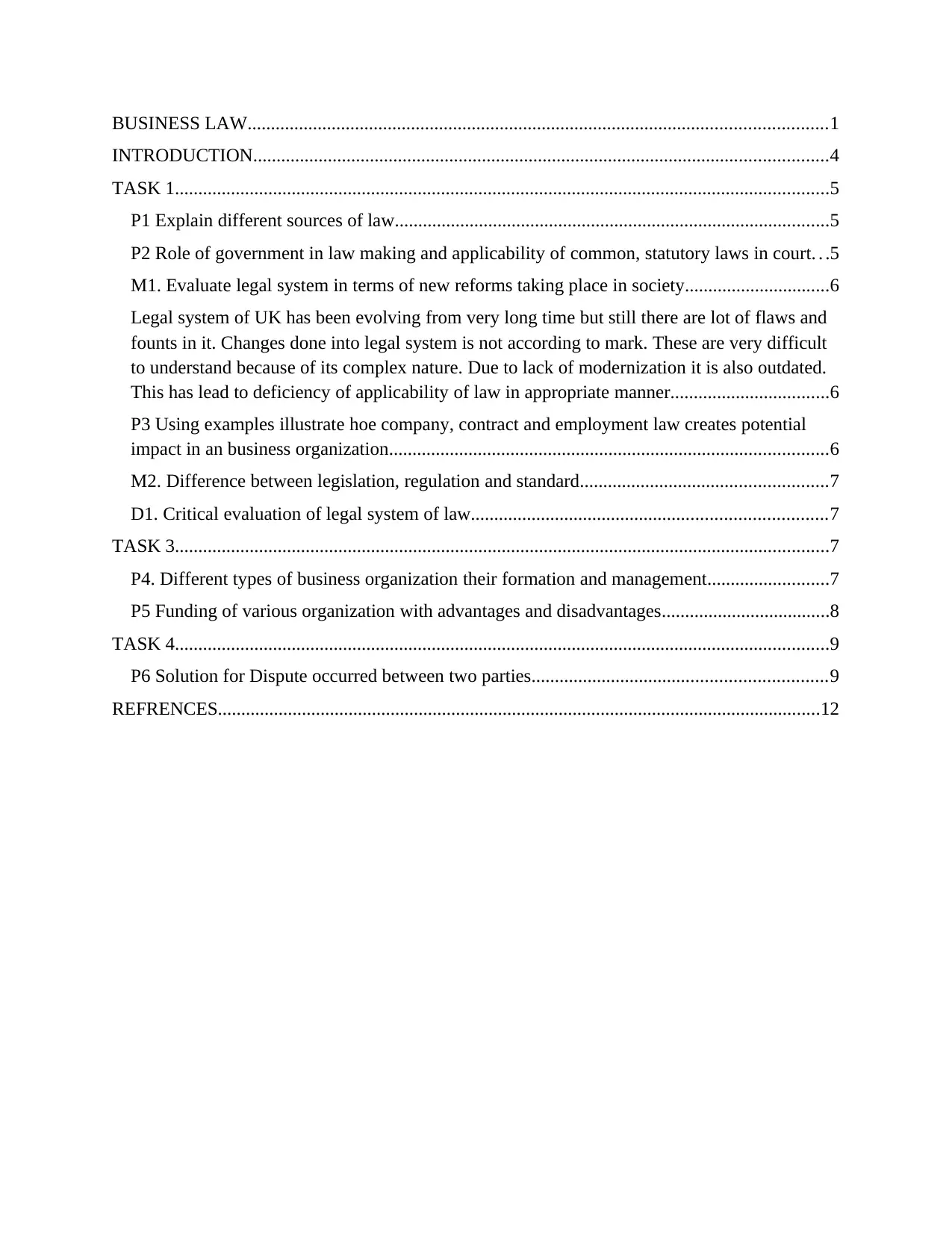
BUSINESS LAW............................................................................................................................1
INTRODUCTION...........................................................................................................................4
TASK 1............................................................................................................................................5
P1 Explain different sources of law.............................................................................................5
P2 Role of government in law making and applicability of common, statutory laws in court. . .5
M1. Evaluate legal system in terms of new reforms taking place in society...............................6
Legal system of UK has been evolving from very long time but still there are lot of flaws and
founts in it. Changes done into legal system is not according to mark. These are very difficult
to understand because of its complex nature. Due to lack of modernization it is also outdated.
This has lead to deficiency of applicability of law in appropriate manner..................................6
P3 Using examples illustrate hoe company, contract and employment law creates potential
impact in an business organization..............................................................................................6
M2. Difference between legislation, regulation and standard.....................................................7
D1. Critical evaluation of legal system of law............................................................................7
TASK 3............................................................................................................................................7
P4. Different types of business organization their formation and management..........................7
P5 Funding of various organization with advantages and disadvantages....................................8
TASK 4............................................................................................................................................9
P6 Solution for Dispute occurred between two parties...............................................................9
REFRENCES.................................................................................................................................12
INTRODUCTION...........................................................................................................................4
TASK 1............................................................................................................................................5
P1 Explain different sources of law.............................................................................................5
P2 Role of government in law making and applicability of common, statutory laws in court. . .5
M1. Evaluate legal system in terms of new reforms taking place in society...............................6
Legal system of UK has been evolving from very long time but still there are lot of flaws and
founts in it. Changes done into legal system is not according to mark. These are very difficult
to understand because of its complex nature. Due to lack of modernization it is also outdated.
This has lead to deficiency of applicability of law in appropriate manner..................................6
P3 Using examples illustrate hoe company, contract and employment law creates potential
impact in an business organization..............................................................................................6
M2. Difference between legislation, regulation and standard.....................................................7
D1. Critical evaluation of legal system of law............................................................................7
TASK 3............................................................................................................................................7
P4. Different types of business organization their formation and management..........................7
P5 Funding of various organization with advantages and disadvantages....................................8
TASK 4............................................................................................................................................9
P6 Solution for Dispute occurred between two parties...............................................................9
REFRENCES.................................................................................................................................12
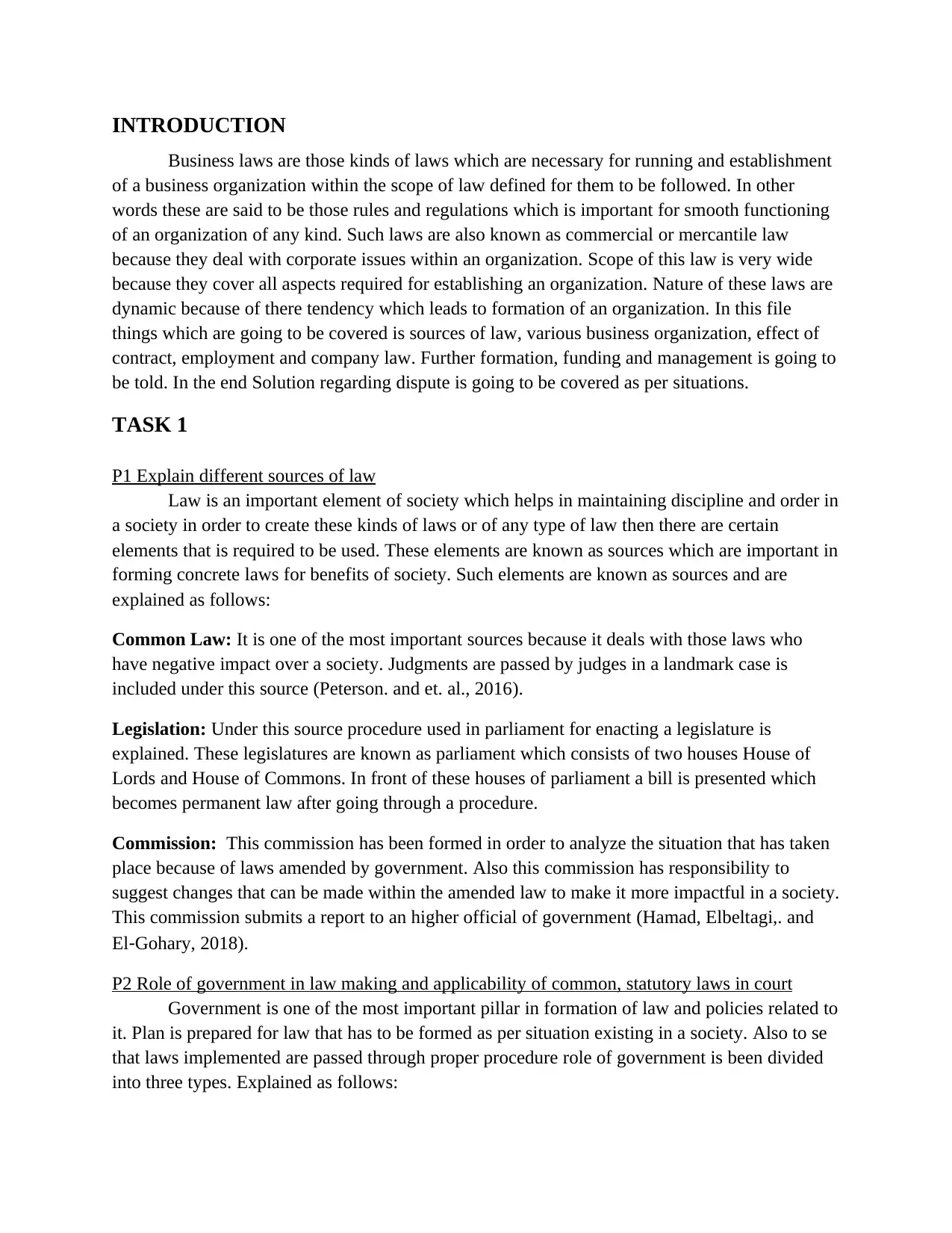
INTRODUCTION
Business laws are those kinds of laws which are necessary for running and establishment
of a business organization within the scope of law defined for them to be followed. In other
words these are said to be those rules and regulations which is important for smooth functioning
of an organization of any kind. Such laws are also known as commercial or mercantile law
because they deal with corporate issues within an organization. Scope of this law is very wide
because they cover all aspects required for establishing an organization. Nature of these laws are
dynamic because of there tendency which leads to formation of an organization. In this file
things which are going to be covered is sources of law, various business organization, effect of
contract, employment and company law. Further formation, funding and management is going to
be told. In the end Solution regarding dispute is going to be covered as per situations.
TASK 1
P1 Explain different sources of law
Law is an important element of society which helps in maintaining discipline and order in
a society in order to create these kinds of laws or of any type of law then there are certain
elements that is required to be used. These elements are known as sources which are important in
forming concrete laws for benefits of society. Such elements are known as sources and are
explained as follows:
Common Law: It is one of the most important sources because it deals with those laws who
have negative impact over a society. Judgments are passed by judges in a landmark case is
included under this source (Peterson. and et. al., 2016).
Legislation: Under this source procedure used in parliament for enacting a legislature is
explained. These legislatures are known as parliament which consists of two houses House of
Lords and House of Commons. In front of these houses of parliament a bill is presented which
becomes permanent law after going through a procedure.
Commission: This commission has been formed in order to analyze the situation that has taken
place because of laws amended by government. Also this commission has responsibility to
suggest changes that can be made within the amended law to make it more impactful in a society.
This commission submits a report to an higher official of government (Hamad, Elbeltagi,. and
El‐Gohary, 2018).
P2 Role of government in law making and applicability of common, statutory laws in court
Government is one of the most important pillar in formation of law and policies related to
it. Plan is prepared for law that has to be formed as per situation existing in a society. Also to se
that laws implemented are passed through proper procedure role of government is been divided
into three types. Explained as follows:
Business laws are those kinds of laws which are necessary for running and establishment
of a business organization within the scope of law defined for them to be followed. In other
words these are said to be those rules and regulations which is important for smooth functioning
of an organization of any kind. Such laws are also known as commercial or mercantile law
because they deal with corporate issues within an organization. Scope of this law is very wide
because they cover all aspects required for establishing an organization. Nature of these laws are
dynamic because of there tendency which leads to formation of an organization. In this file
things which are going to be covered is sources of law, various business organization, effect of
contract, employment and company law. Further formation, funding and management is going to
be told. In the end Solution regarding dispute is going to be covered as per situations.
TASK 1
P1 Explain different sources of law
Law is an important element of society which helps in maintaining discipline and order in
a society in order to create these kinds of laws or of any type of law then there are certain
elements that is required to be used. These elements are known as sources which are important in
forming concrete laws for benefits of society. Such elements are known as sources and are
explained as follows:
Common Law: It is one of the most important sources because it deals with those laws who
have negative impact over a society. Judgments are passed by judges in a landmark case is
included under this source (Peterson. and et. al., 2016).
Legislation: Under this source procedure used in parliament for enacting a legislature is
explained. These legislatures are known as parliament which consists of two houses House of
Lords and House of Commons. In front of these houses of parliament a bill is presented which
becomes permanent law after going through a procedure.
Commission: This commission has been formed in order to analyze the situation that has taken
place because of laws amended by government. Also this commission has responsibility to
suggest changes that can be made within the amended law to make it more impactful in a society.
This commission submits a report to an higher official of government (Hamad, Elbeltagi,. and
El‐Gohary, 2018).
P2 Role of government in law making and applicability of common, statutory laws in court
Government is one of the most important pillar in formation of law and policies related to
it. Plan is prepared for law that has to be formed as per situation existing in a society. Also to se
that laws implemented are passed through proper procedure role of government is been divided
into three types. Explained as follows:
⊘ This is a preview!⊘
Do you want full access?
Subscribe today to unlock all pages.

Trusted by 1+ million students worldwide
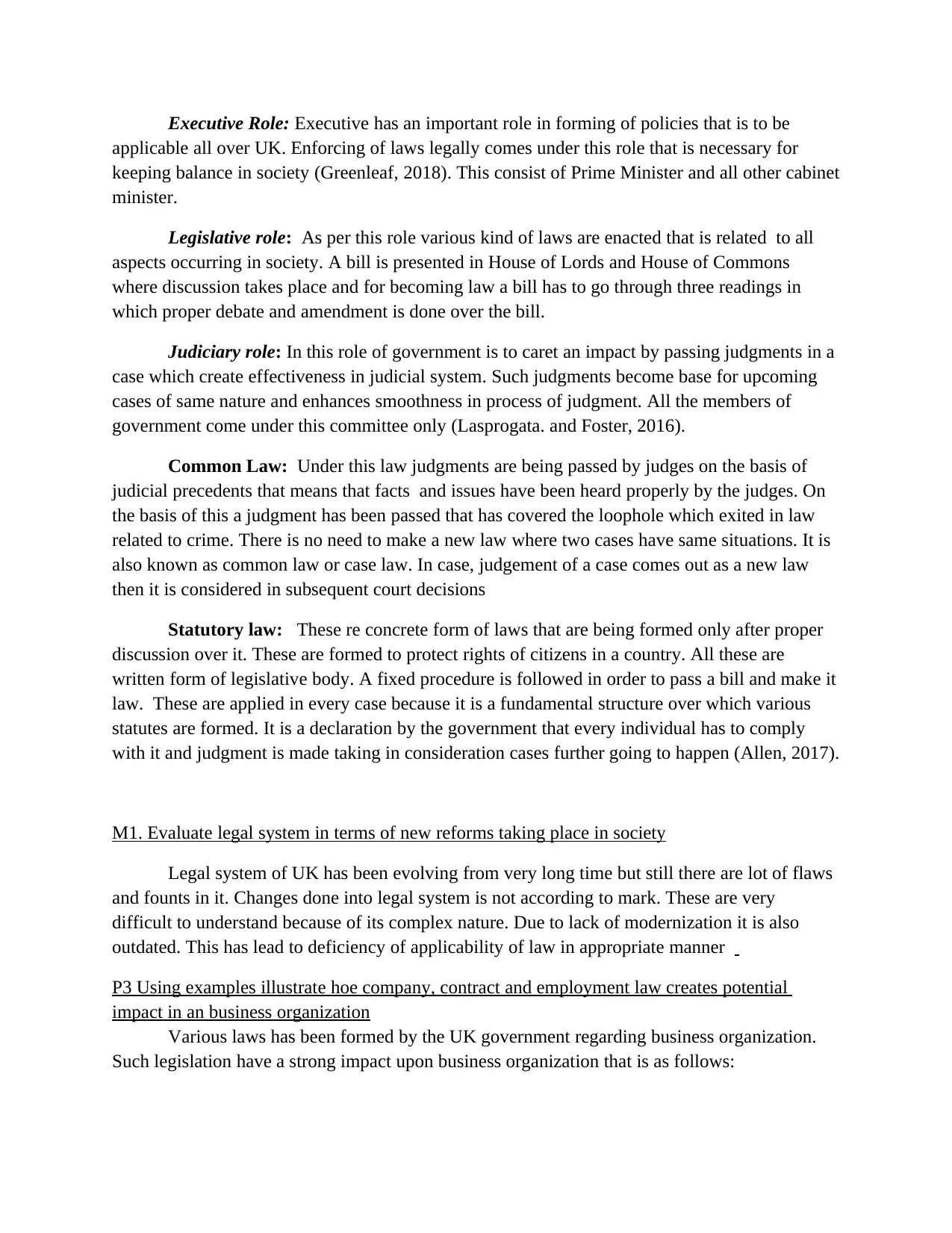
Executive Role: Executive has an important role in forming of policies that is to be
applicable all over UK. Enforcing of laws legally comes under this role that is necessary for
keeping balance in society (Greenleaf, 2018). This consist of Prime Minister and all other cabinet
minister.
Legislative role: As per this role various kind of laws are enacted that is related to all
aspects occurring in society. A bill is presented in House of Lords and House of Commons
where discussion takes place and for becoming law a bill has to go through three readings in
which proper debate and amendment is done over the bill.
Judiciary role: In this role of government is to caret an impact by passing judgments in a
case which create effectiveness in judicial system. Such judgments become base for upcoming
cases of same nature and enhances smoothness in process of judgment. All the members of
government come under this committee only (Lasprogata. and Foster, 2016).
Common Law: Under this law judgments are being passed by judges on the basis of
judicial precedents that means that facts and issues have been heard properly by the judges. On
the basis of this a judgment has been passed that has covered the loophole which exited in law
related to crime. There is no need to make a new law where two cases have same situations. It is
also known as common law or case law. In case, judgement of a case comes out as a new law
then it is considered in subsequent court decisions
Statutory law: These re concrete form of laws that are being formed only after proper
discussion over it. These are formed to protect rights of citizens in a country. All these are
written form of legislative body. A fixed procedure is followed in order to pass a bill and make it
law. These are applied in every case because it is a fundamental structure over which various
statutes are formed. It is a declaration by the government that every individual has to comply
with it and judgment is made taking in consideration cases further going to happen (Allen, 2017).
M1. Evaluate legal system in terms of new reforms taking place in society
Legal system of UK has been evolving from very long time but still there are lot of flaws
and founts in it. Changes done into legal system is not according to mark. These are very
difficult to understand because of its complex nature. Due to lack of modernization it is also
outdated. This has lead to deficiency of applicability of law in appropriate manner
P3 Using examples illustrate hoe company, contract and employment law creates potential
impact in an business organization
Various laws has been formed by the UK government regarding business organization.
Such legislation have a strong impact upon business organization that is as follows:
applicable all over UK. Enforcing of laws legally comes under this role that is necessary for
keeping balance in society (Greenleaf, 2018). This consist of Prime Minister and all other cabinet
minister.
Legislative role: As per this role various kind of laws are enacted that is related to all
aspects occurring in society. A bill is presented in House of Lords and House of Commons
where discussion takes place and for becoming law a bill has to go through three readings in
which proper debate and amendment is done over the bill.
Judiciary role: In this role of government is to caret an impact by passing judgments in a
case which create effectiveness in judicial system. Such judgments become base for upcoming
cases of same nature and enhances smoothness in process of judgment. All the members of
government come under this committee only (Lasprogata. and Foster, 2016).
Common Law: Under this law judgments are being passed by judges on the basis of
judicial precedents that means that facts and issues have been heard properly by the judges. On
the basis of this a judgment has been passed that has covered the loophole which exited in law
related to crime. There is no need to make a new law where two cases have same situations. It is
also known as common law or case law. In case, judgement of a case comes out as a new law
then it is considered in subsequent court decisions
Statutory law: These re concrete form of laws that are being formed only after proper
discussion over it. These are formed to protect rights of citizens in a country. All these are
written form of legislative body. A fixed procedure is followed in order to pass a bill and make it
law. These are applied in every case because it is a fundamental structure over which various
statutes are formed. It is a declaration by the government that every individual has to comply
with it and judgment is made taking in consideration cases further going to happen (Allen, 2017).
M1. Evaluate legal system in terms of new reforms taking place in society
Legal system of UK has been evolving from very long time but still there are lot of flaws
and founts in it. Changes done into legal system is not according to mark. These are very
difficult to understand because of its complex nature. Due to lack of modernization it is also
outdated. This has lead to deficiency of applicability of law in appropriate manner
P3 Using examples illustrate hoe company, contract and employment law creates potential
impact in an business organization
Various laws has been formed by the UK government regarding business organization.
Such legislation have a strong impact upon business organization that is as follows:
Paraphrase This Document
Need a fresh take? Get an instant paraphrase of this document with our AI Paraphraser
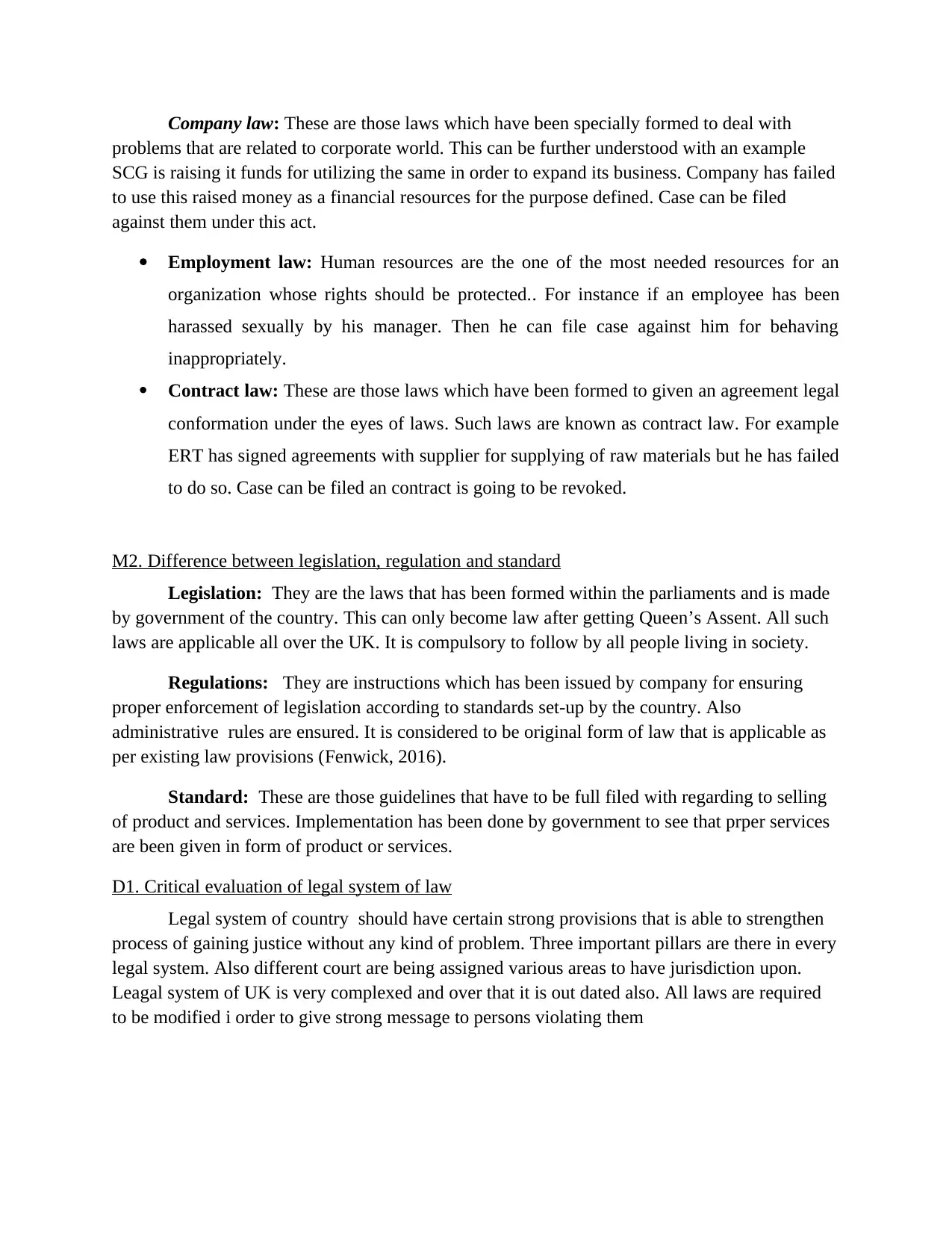
Company law: These are those laws which have been specially formed to deal with
problems that are related to corporate world. This can be further understood with an example
SCG is raising it funds for utilizing the same in order to expand its business. Company has failed
to use this raised money as a financial resources for the purpose defined. Case can be filed
against them under this act.
Employment law: Human resources are the one of the most needed resources for an
organization whose rights should be protected.. For instance if an employee has been
harassed sexually by his manager. Then he can file case against him for behaving
inappropriately.
Contract law: These are those laws which have been formed to given an agreement legal
conformation under the eyes of laws. Such laws are known as contract law. For example
ERT has signed agreements with supplier for supplying of raw materials but he has failed
to do so. Case can be filed an contract is going to be revoked.
M2. Difference between legislation, regulation and standard
Legislation: They are the laws that has been formed within the parliaments and is made
by government of the country. This can only become law after getting Queen’s Assent. All such
laws are applicable all over the UK. It is compulsory to follow by all people living in society.
Regulations: They are instructions which has been issued by company for ensuring
proper enforcement of legislation according to standards set-up by the country. Also
administrative rules are ensured. It is considered to be original form of law that is applicable as
per existing law provisions (Fenwick, 2016).
Standard: These are those guidelines that have to be full filed with regarding to selling
of product and services. Implementation has been done by government to see that prper services
are been given in form of product or services.
D1. Critical evaluation of legal system of law
Legal system of country should have certain strong provisions that is able to strengthen
process of gaining justice without any kind of problem. Three important pillars are there in every
legal system. Also different court are being assigned various areas to have jurisdiction upon.
Leagal system of UK is very complexed and over that it is out dated also. All laws are required
to be modified i order to give strong message to persons violating them
problems that are related to corporate world. This can be further understood with an example
SCG is raising it funds for utilizing the same in order to expand its business. Company has failed
to use this raised money as a financial resources for the purpose defined. Case can be filed
against them under this act.
Employment law: Human resources are the one of the most needed resources for an
organization whose rights should be protected.. For instance if an employee has been
harassed sexually by his manager. Then he can file case against him for behaving
inappropriately.
Contract law: These are those laws which have been formed to given an agreement legal
conformation under the eyes of laws. Such laws are known as contract law. For example
ERT has signed agreements with supplier for supplying of raw materials but he has failed
to do so. Case can be filed an contract is going to be revoked.
M2. Difference between legislation, regulation and standard
Legislation: They are the laws that has been formed within the parliaments and is made
by government of the country. This can only become law after getting Queen’s Assent. All such
laws are applicable all over the UK. It is compulsory to follow by all people living in society.
Regulations: They are instructions which has been issued by company for ensuring
proper enforcement of legislation according to standards set-up by the country. Also
administrative rules are ensured. It is considered to be original form of law that is applicable as
per existing law provisions (Fenwick, 2016).
Standard: These are those guidelines that have to be full filed with regarding to selling
of product and services. Implementation has been done by government to see that prper services
are been given in form of product or services.
D1. Critical evaluation of legal system of law
Legal system of country should have certain strong provisions that is able to strengthen
process of gaining justice without any kind of problem. Three important pillars are there in every
legal system. Also different court are being assigned various areas to have jurisdiction upon.
Leagal system of UK is very complexed and over that it is out dated also. All laws are required
to be modified i order to give strong message to persons violating them
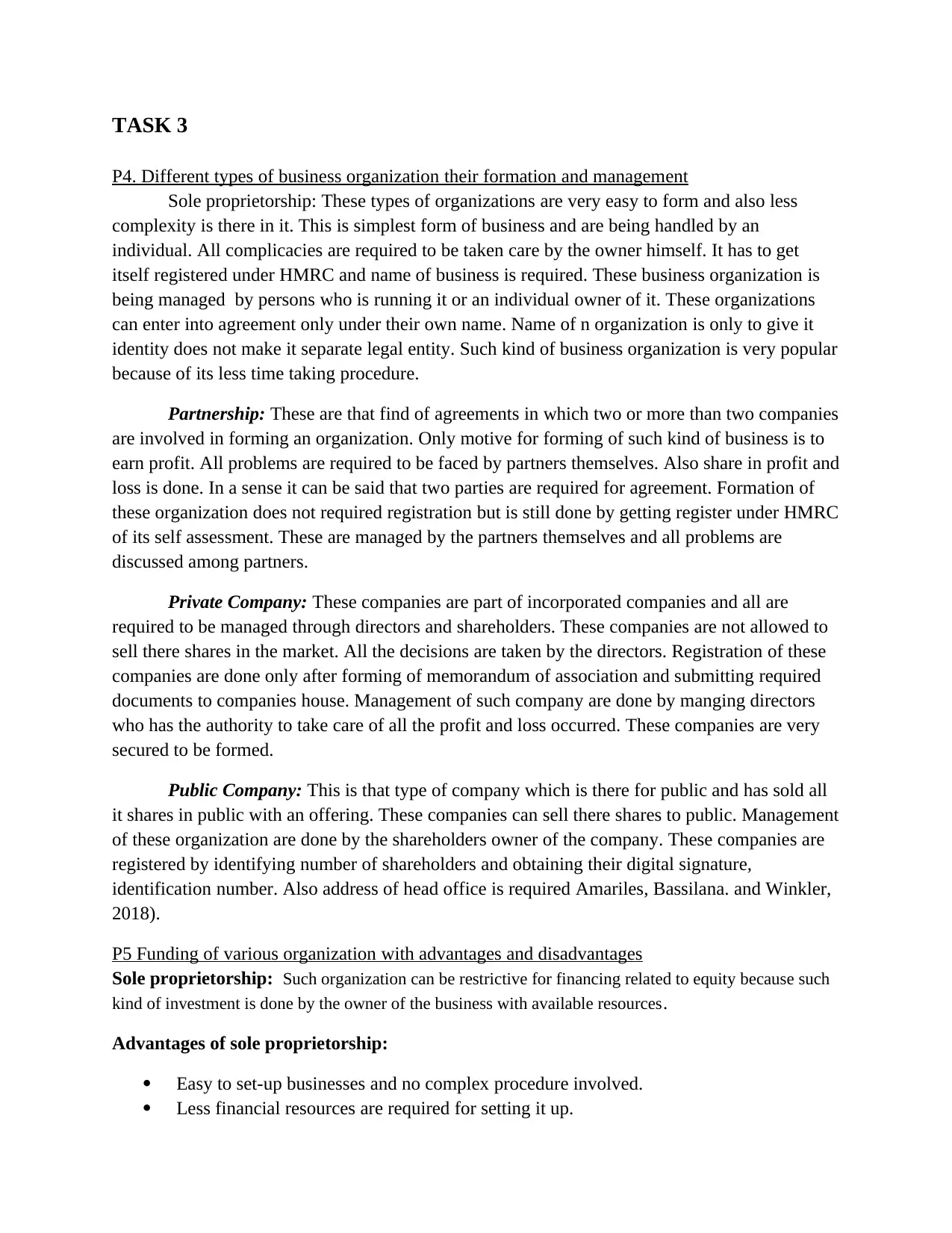
TASK 3
P4. Different types of business organization their formation and management
Sole proprietorship: These types of organizations are very easy to form and also less
complexity is there in it. This is simplest form of business and are being handled by an
individual. All complicacies are required to be taken care by the owner himself. It has to get
itself registered under HMRC and name of business is required. These business organization is
being managed by persons who is running it or an individual owner of it. These organizations
can enter into agreement only under their own name. Name of n organization is only to give it
identity does not make it separate legal entity. Such kind of business organization is very popular
because of its less time taking procedure.
Partnership: These are that find of agreements in which two or more than two companies
are involved in forming an organization. Only motive for forming of such kind of business is to
earn profit. All problems are required to be faced by partners themselves. Also share in profit and
loss is done. In a sense it can be said that two parties are required for agreement. Formation of
these organization does not required registration but is still done by getting register under HMRC
of its self assessment. These are managed by the partners themselves and all problems are
discussed among partners.
Private Company: These companies are part of incorporated companies and all are
required to be managed through directors and shareholders. These companies are not allowed to
sell there shares in the market. All the decisions are taken by the directors. Registration of these
companies are done only after forming of memorandum of association and submitting required
documents to companies house. Management of such company are done by manging directors
who has the authority to take care of all the profit and loss occurred. These companies are very
secured to be formed.
Public Company: This is that type of company which is there for public and has sold all
it shares in public with an offering. These companies can sell there shares to public. Management
of these organization are done by the shareholders owner of the company. These companies are
registered by identifying number of shareholders and obtaining their digital signature,
identification number. Also address of head office is required Amariles, Bassilana. and Winkler,
2018).
P5 Funding of various organization with advantages and disadvantages
Sole proprietorship: Such organization can be restrictive for financing related to equity because such
kind of investment is done by the owner of the business with available resources.
Advantages of sole proprietorship:
Easy to set-up businesses and no complex procedure involved.
Less financial resources are required for setting it up.
P4. Different types of business organization their formation and management
Sole proprietorship: These types of organizations are very easy to form and also less
complexity is there in it. This is simplest form of business and are being handled by an
individual. All complicacies are required to be taken care by the owner himself. It has to get
itself registered under HMRC and name of business is required. These business organization is
being managed by persons who is running it or an individual owner of it. These organizations
can enter into agreement only under their own name. Name of n organization is only to give it
identity does not make it separate legal entity. Such kind of business organization is very popular
because of its less time taking procedure.
Partnership: These are that find of agreements in which two or more than two companies
are involved in forming an organization. Only motive for forming of such kind of business is to
earn profit. All problems are required to be faced by partners themselves. Also share in profit and
loss is done. In a sense it can be said that two parties are required for agreement. Formation of
these organization does not required registration but is still done by getting register under HMRC
of its self assessment. These are managed by the partners themselves and all problems are
discussed among partners.
Private Company: These companies are part of incorporated companies and all are
required to be managed through directors and shareholders. These companies are not allowed to
sell there shares in the market. All the decisions are taken by the directors. Registration of these
companies are done only after forming of memorandum of association and submitting required
documents to companies house. Management of such company are done by manging directors
who has the authority to take care of all the profit and loss occurred. These companies are very
secured to be formed.
Public Company: This is that type of company which is there for public and has sold all
it shares in public with an offering. These companies can sell there shares to public. Management
of these organization are done by the shareholders owner of the company. These companies are
registered by identifying number of shareholders and obtaining their digital signature,
identification number. Also address of head office is required Amariles, Bassilana. and Winkler,
2018).
P5 Funding of various organization with advantages and disadvantages
Sole proprietorship: Such organization can be restrictive for financing related to equity because such
kind of investment is done by the owner of the business with available resources.
Advantages of sole proprietorship:
Easy to set-up businesses and no complex procedure involved.
Less financial resources are required for setting it up.
⊘ This is a preview!⊘
Do you want full access?
Subscribe today to unlock all pages.

Trusted by 1+ million students worldwide
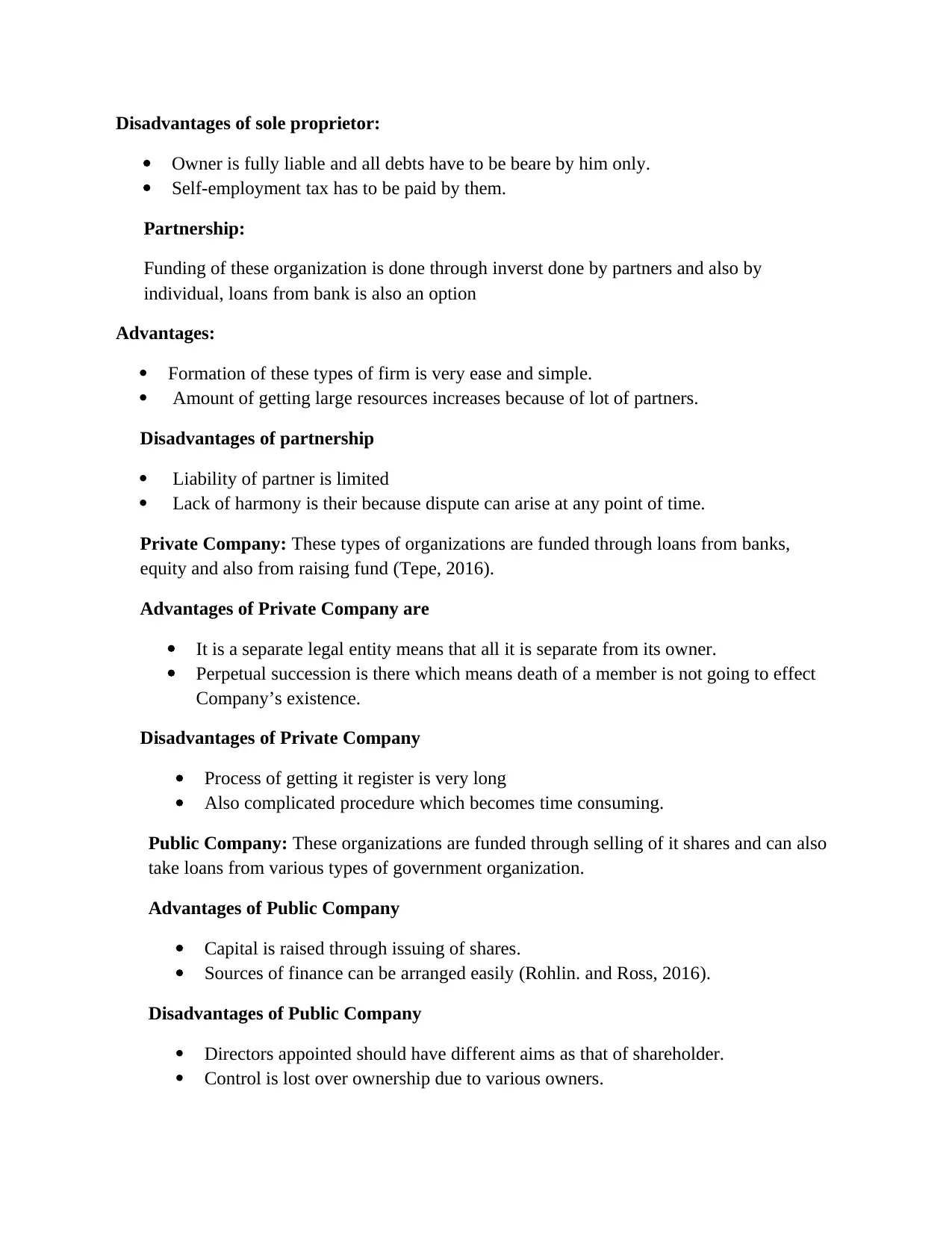
Disadvantages of sole proprietor:
Owner is fully liable and all debts have to be beare by him only.
Self-employment tax has to be paid by them.
Partnership:
Funding of these organization is done through inverst done by partners and also by
individual, loans from bank is also an option
Advantages:
Formation of these types of firm is very ease and simple.
Amount of getting large resources increases because of lot of partners.
Disadvantages of partnership
Liability of partner is limited
Lack of harmony is their because dispute can arise at any point of time.
Private Company: These types of organizations are funded through loans from banks,
equity and also from raising fund (Tepe, 2016).
Advantages of Private Company are
It is a separate legal entity means that all it is separate from its owner.
Perpetual succession is there which means death of a member is not going to effect
Company’s existence.
Disadvantages of Private Company
Process of getting it register is very long
Also complicated procedure which becomes time consuming.
Public Company: These organizations are funded through selling of it shares and can also
take loans from various types of government organization.
Advantages of Public Company
Capital is raised through issuing of shares.
Sources of finance can be arranged easily (Rohlin. and Ross, 2016).
Disadvantages of Public Company
Directors appointed should have different aims as that of shareholder.
Control is lost over ownership due to various owners.
Owner is fully liable and all debts have to be beare by him only.
Self-employment tax has to be paid by them.
Partnership:
Funding of these organization is done through inverst done by partners and also by
individual, loans from bank is also an option
Advantages:
Formation of these types of firm is very ease and simple.
Amount of getting large resources increases because of lot of partners.
Disadvantages of partnership
Liability of partner is limited
Lack of harmony is their because dispute can arise at any point of time.
Private Company: These types of organizations are funded through loans from banks,
equity and also from raising fund (Tepe, 2016).
Advantages of Private Company are
It is a separate legal entity means that all it is separate from its owner.
Perpetual succession is there which means death of a member is not going to effect
Company’s existence.
Disadvantages of Private Company
Process of getting it register is very long
Also complicated procedure which becomes time consuming.
Public Company: These organizations are funded through selling of it shares and can also
take loans from various types of government organization.
Advantages of Public Company
Capital is raised through issuing of shares.
Sources of finance can be arranged easily (Rohlin. and Ross, 2016).
Disadvantages of Public Company
Directors appointed should have different aims as that of shareholder.
Control is lost over ownership due to various owners.
Paraphrase This Document
Need a fresh take? Get an instant paraphrase of this document with our AI Paraphraser
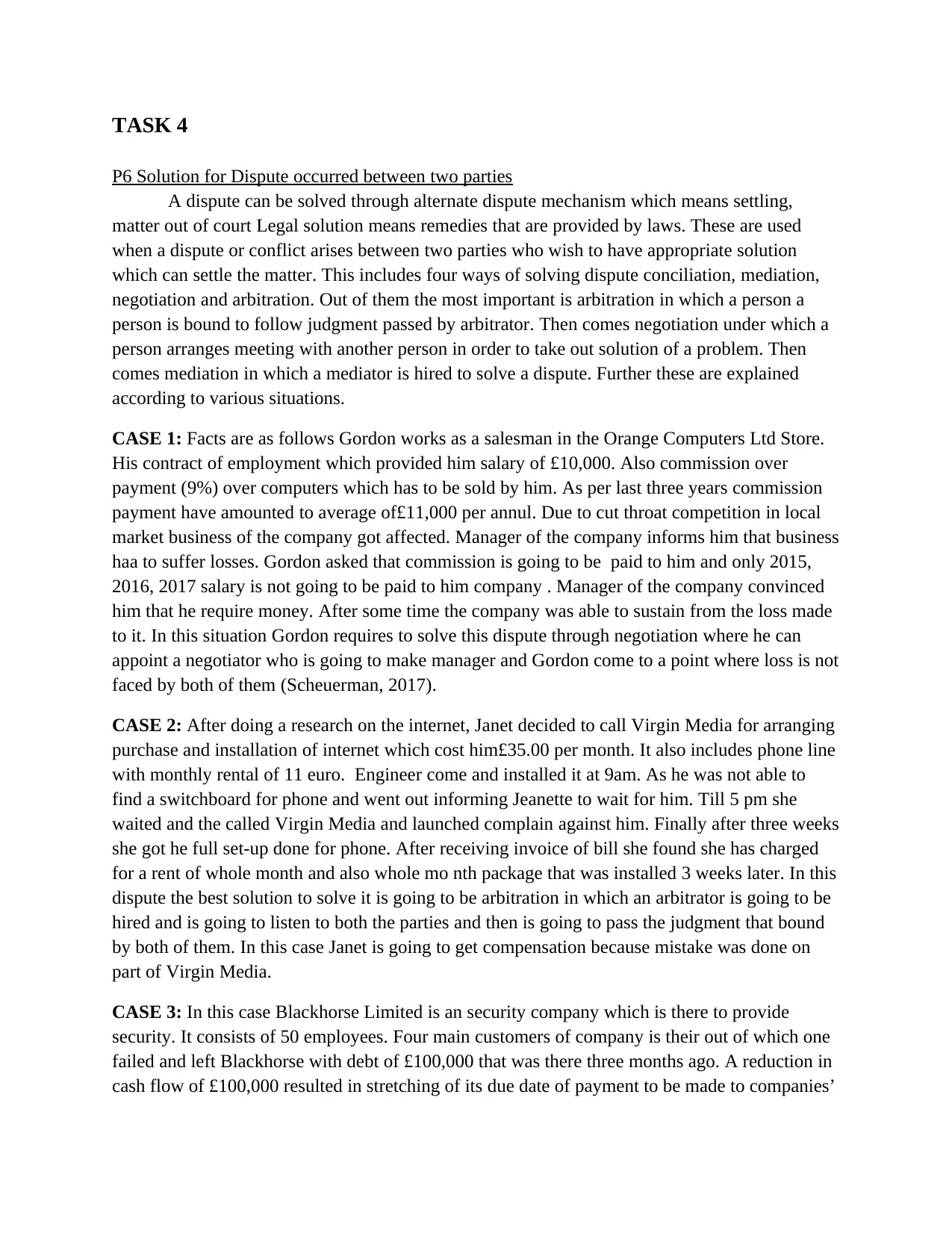
TASK 4
P6 Solution for Dispute occurred between two parties
A dispute can be solved through alternate dispute mechanism which means settling,
matter out of court Legal solution means remedies that are provided by laws. These are used
when a dispute or conflict arises between two parties who wish to have appropriate solution
which can settle the matter. This includes four ways of solving dispute conciliation, mediation,
negotiation and arbitration. Out of them the most important is arbitration in which a person a
person is bound to follow judgment passed by arbitrator. Then comes negotiation under which a
person arranges meeting with another person in order to take out solution of a problem. Then
comes mediation in which a mediator is hired to solve a dispute. Further these are explained
according to various situations.
CASE 1: Facts are as follows Gordon works as a salesman in the Orange Computers Ltd Store.
His contract of employment which provided him salary of £10,000. Also commission over
payment (9%) over computers which has to be sold by him. As per last three years commission
payment have amounted to average of£11,000 per annul. Due to cut throat competition in local
market business of the company got affected. Manager of the company informs him that business
haa to suffer losses. Gordon asked that commission is going to be paid to him and only 2015,
2016, 2017 salary is not going to be paid to him company . Manager of the company convinced
him that he require money. After some time the company was able to sustain from the loss made
to it. In this situation Gordon requires to solve this dispute through negotiation where he can
appoint a negotiator who is going to make manager and Gordon come to a point where loss is not
faced by both of them (Scheuerman, 2017).
CASE 2: After doing a research on the internet, Janet decided to call Virgin Media for arranging
purchase and installation of internet which cost him£35.00 per month. It also includes phone line
with monthly rental of 11 euro. Engineer come and installed it at 9am. As he was not able to
find a switchboard for phone and went out informing Jeanette to wait for him. Till 5 pm she
waited and the called Virgin Media and launched complain against him. Finally after three weeks
she got he full set-up done for phone. After receiving invoice of bill she found she has charged
for a rent of whole month and also whole mo nth package that was installed 3 weeks later. In this
dispute the best solution to solve it is going to be arbitration in which an arbitrator is going to be
hired and is going to listen to both the parties and then is going to pass the judgment that bound
by both of them. In this case Janet is going to get compensation because mistake was done on
part of Virgin Media.
CASE 3: In this case Blackhorse Limited is an security company which is there to provide
security. It consists of 50 employees. Four main customers of company is their out of which one
failed and left Blackhorse with debt of £100,000 that was there three months ago. A reduction in
cash flow of £100,000 resulted in stretching of its due date of payment to be made to companies’
P6 Solution for Dispute occurred between two parties
A dispute can be solved through alternate dispute mechanism which means settling,
matter out of court Legal solution means remedies that are provided by laws. These are used
when a dispute or conflict arises between two parties who wish to have appropriate solution
which can settle the matter. This includes four ways of solving dispute conciliation, mediation,
negotiation and arbitration. Out of them the most important is arbitration in which a person a
person is bound to follow judgment passed by arbitrator. Then comes negotiation under which a
person arranges meeting with another person in order to take out solution of a problem. Then
comes mediation in which a mediator is hired to solve a dispute. Further these are explained
according to various situations.
CASE 1: Facts are as follows Gordon works as a salesman in the Orange Computers Ltd Store.
His contract of employment which provided him salary of £10,000. Also commission over
payment (9%) over computers which has to be sold by him. As per last three years commission
payment have amounted to average of£11,000 per annul. Due to cut throat competition in local
market business of the company got affected. Manager of the company informs him that business
haa to suffer losses. Gordon asked that commission is going to be paid to him and only 2015,
2016, 2017 salary is not going to be paid to him company . Manager of the company convinced
him that he require money. After some time the company was able to sustain from the loss made
to it. In this situation Gordon requires to solve this dispute through negotiation where he can
appoint a negotiator who is going to make manager and Gordon come to a point where loss is not
faced by both of them (Scheuerman, 2017).
CASE 2: After doing a research on the internet, Janet decided to call Virgin Media for arranging
purchase and installation of internet which cost him£35.00 per month. It also includes phone line
with monthly rental of 11 euro. Engineer come and installed it at 9am. As he was not able to
find a switchboard for phone and went out informing Jeanette to wait for him. Till 5 pm she
waited and the called Virgin Media and launched complain against him. Finally after three weeks
she got he full set-up done for phone. After receiving invoice of bill she found she has charged
for a rent of whole month and also whole mo nth package that was installed 3 weeks later. In this
dispute the best solution to solve it is going to be arbitration in which an arbitrator is going to be
hired and is going to listen to both the parties and then is going to pass the judgment that bound
by both of them. In this case Janet is going to get compensation because mistake was done on
part of Virgin Media.
CASE 3: In this case Blackhorse Limited is an security company which is there to provide
security. It consists of 50 employees. Four main customers of company is their out of which one
failed and left Blackhorse with debt of £100,000 that was there three months ago. A reduction in
cash flow of £100,000 resulted in stretching of its due date of payment to be made to companies’
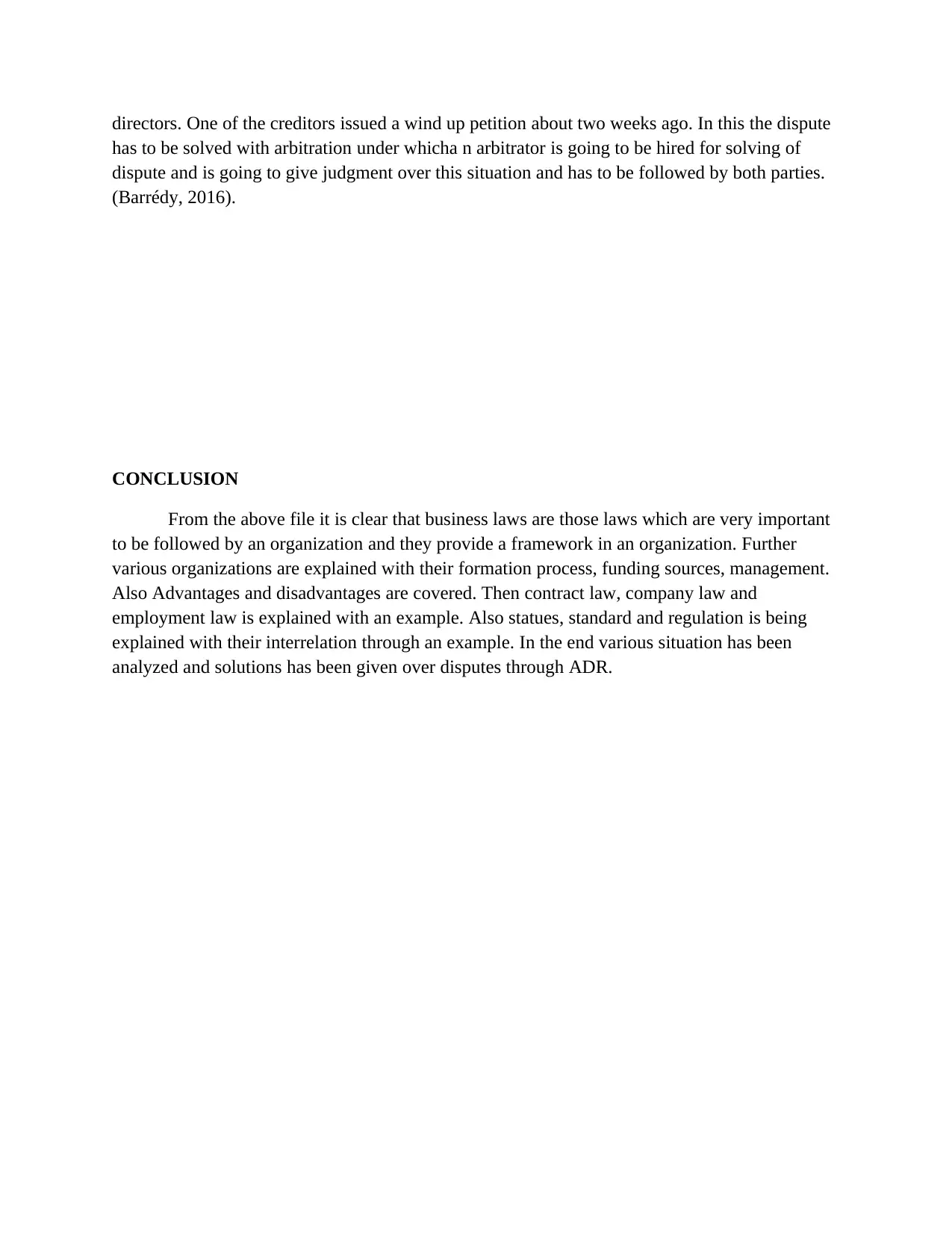
directors. One of the creditors issued a wind up petition about two weeks ago. In this the dispute
has to be solved with arbitration under whicha n arbitrator is going to be hired for solving of
dispute and is going to give judgment over this situation and has to be followed by both parties.
(Barrédy, 2016).
CONCLUSION
From the above file it is clear that business laws are those laws which are very important
to be followed by an organization and they provide a framework in an organization. Further
various organizations are explained with their formation process, funding sources, management.
Also Advantages and disadvantages are covered. Then contract law, company law and
employment law is explained with an example. Also statues, standard and regulation is being
explained with their interrelation through an example. In the end various situation has been
analyzed and solutions has been given over disputes through ADR.
has to be solved with arbitration under whicha n arbitrator is going to be hired for solving of
dispute and is going to give judgment over this situation and has to be followed by both parties.
(Barrédy, 2016).
CONCLUSION
From the above file it is clear that business laws are those laws which are very important
to be followed by an organization and they provide a framework in an organization. Further
various organizations are explained with their formation process, funding sources, management.
Also Advantages and disadvantages are covered. Then contract law, company law and
employment law is explained with an example. Also statues, standard and regulation is being
explained with their interrelation through an example. In the end various situation has been
analyzed and solutions has been given over disputes through ADR.
⊘ This is a preview!⊘
Do you want full access?
Subscribe today to unlock all pages.

Trusted by 1+ million students worldwide
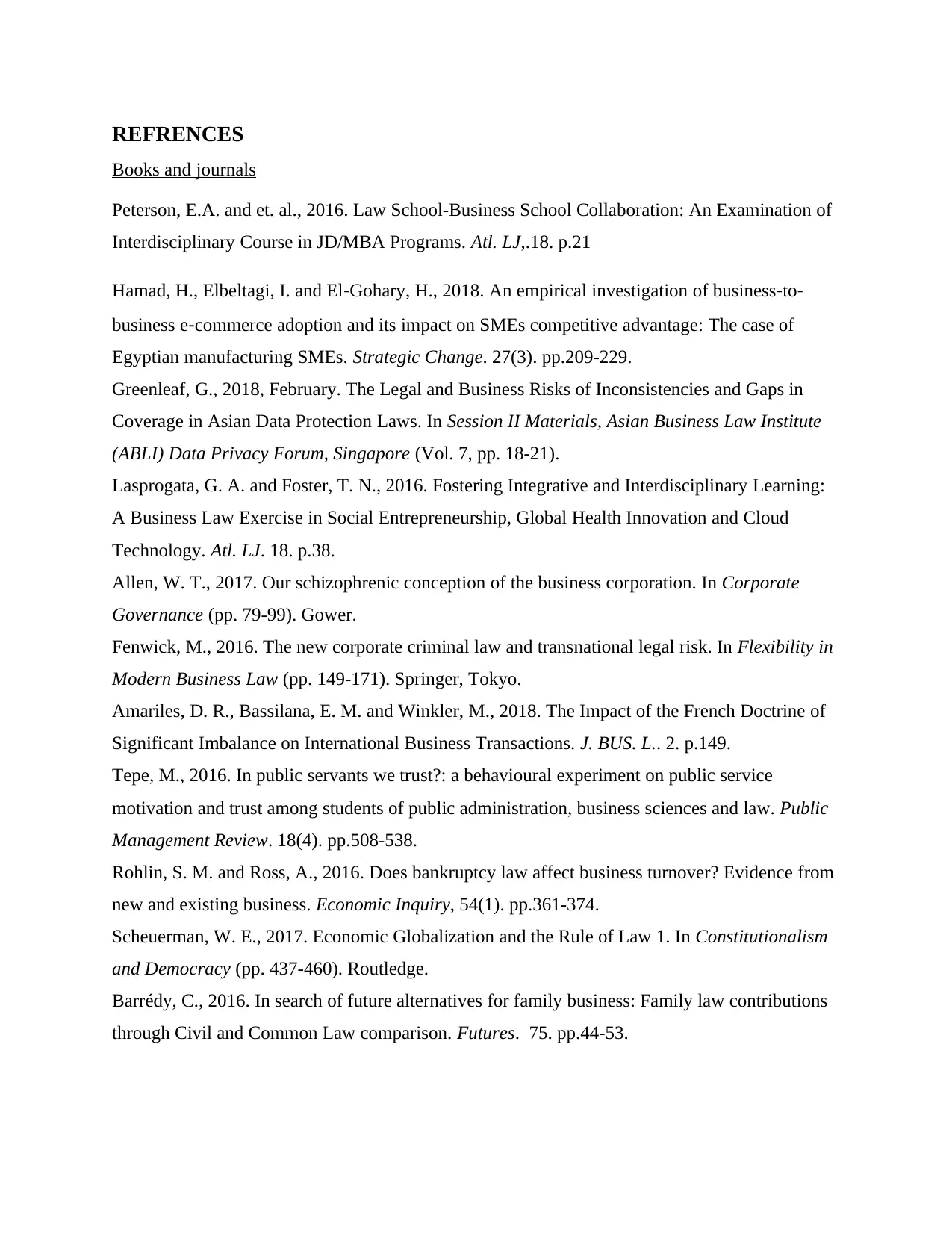
REFRENCES
Books and journals
Peterson, E.A. and et. al., 2016. Law School-Business School Collaboration: An Examination of
Interdisciplinary Course in JD/MBA Programs. Atl. LJ,.18. p.21
Hamad, H., Elbeltagi, I. and El‐Gohary, H., 2018. An empirical investigation of business‐to‐
business e‐commerce adoption and its impact on SMEs competitive advantage: The case of
Egyptian manufacturing SMEs. Strategic Change. 27(3). pp.209-229.
Greenleaf, G., 2018, February. The Legal and Business Risks of Inconsistencies and Gaps in
Coverage in Asian Data Protection Laws. In Session II Materials, Asian Business Law Institute
(ABLI) Data Privacy Forum, Singapore (Vol. 7, pp. 18-21).
Lasprogata, G. A. and Foster, T. N., 2016. Fostering Integrative and Interdisciplinary Learning:
A Business Law Exercise in Social Entrepreneurship, Global Health Innovation and Cloud
Technology. Atl. LJ. 18. p.38.
Allen, W. T., 2017. Our schizophrenic conception of the business corporation. In Corporate
Governance (pp. 79-99). Gower.
Fenwick, M., 2016. The new corporate criminal law and transnational legal risk. In Flexibility in
Modern Business Law (pp. 149-171). Springer, Tokyo.
Amariles, D. R., Bassilana, E. M. and Winkler, M., 2018. The Impact of the French Doctrine of
Significant Imbalance on International Business Transactions. J. BUS. L.. 2. p.149.
Tepe, M., 2016. In public servants we trust?: a behavioural experiment on public service
motivation and trust among students of public administration, business sciences and law. Public
Management Review. 18(4). pp.508-538.
Rohlin, S. M. and Ross, A., 2016. Does bankruptcy law affect business turnover? Evidence from
new and existing business. Economic Inquiry, 54(1). pp.361-374.
Scheuerman, W. E., 2017. Economic Globalization and the Rule of Law 1. In Constitutionalism
and Democracy (pp. 437-460). Routledge.
Barrédy, C., 2016. In search of future alternatives for family business: Family law contributions
through Civil and Common Law comparison. Futures. 75. pp.44-53.
Books and journals
Peterson, E.A. and et. al., 2016. Law School-Business School Collaboration: An Examination of
Interdisciplinary Course in JD/MBA Programs. Atl. LJ,.18. p.21
Hamad, H., Elbeltagi, I. and El‐Gohary, H., 2018. An empirical investigation of business‐to‐
business e‐commerce adoption and its impact on SMEs competitive advantage: The case of
Egyptian manufacturing SMEs. Strategic Change. 27(3). pp.209-229.
Greenleaf, G., 2018, February. The Legal and Business Risks of Inconsistencies and Gaps in
Coverage in Asian Data Protection Laws. In Session II Materials, Asian Business Law Institute
(ABLI) Data Privacy Forum, Singapore (Vol. 7, pp. 18-21).
Lasprogata, G. A. and Foster, T. N., 2016. Fostering Integrative and Interdisciplinary Learning:
A Business Law Exercise in Social Entrepreneurship, Global Health Innovation and Cloud
Technology. Atl. LJ. 18. p.38.
Allen, W. T., 2017. Our schizophrenic conception of the business corporation. In Corporate
Governance (pp. 79-99). Gower.
Fenwick, M., 2016. The new corporate criminal law and transnational legal risk. In Flexibility in
Modern Business Law (pp. 149-171). Springer, Tokyo.
Amariles, D. R., Bassilana, E. M. and Winkler, M., 2018. The Impact of the French Doctrine of
Significant Imbalance on International Business Transactions. J. BUS. L.. 2. p.149.
Tepe, M., 2016. In public servants we trust?: a behavioural experiment on public service
motivation and trust among students of public administration, business sciences and law. Public
Management Review. 18(4). pp.508-538.
Rohlin, S. M. and Ross, A., 2016. Does bankruptcy law affect business turnover? Evidence from
new and existing business. Economic Inquiry, 54(1). pp.361-374.
Scheuerman, W. E., 2017. Economic Globalization and the Rule of Law 1. In Constitutionalism
and Democracy (pp. 437-460). Routledge.
Barrédy, C., 2016. In search of future alternatives for family business: Family law contributions
through Civil and Common Law comparison. Futures. 75. pp.44-53.
Paraphrase This Document
Need a fresh take? Get an instant paraphrase of this document with our AI Paraphraser
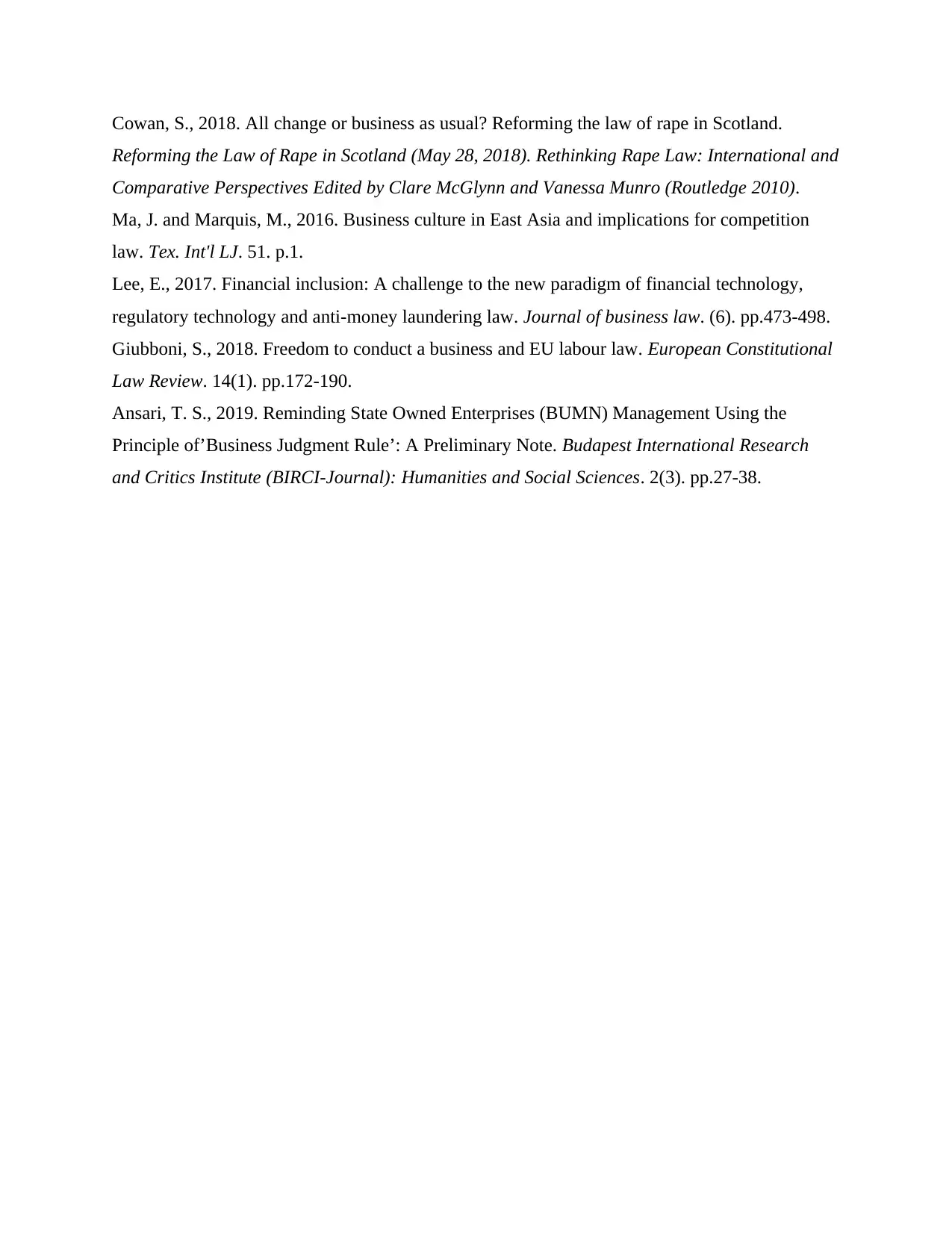
Cowan, S., 2018. All change or business as usual? Reforming the law of rape in Scotland.
Reforming the Law of Rape in Scotland (May 28, 2018). Rethinking Rape Law: International and
Comparative Perspectives Edited by Clare McGlynn and Vanessa Munro (Routledge 2010).
Ma, J. and Marquis, M., 2016. Business culture in East Asia and implications for competition
law. Tex. Int'l LJ. 51. p.1.
Lee, E., 2017. Financial inclusion: A challenge to the new paradigm of financial technology,
regulatory technology and anti-money laundering law. Journal of business law. (6). pp.473-498.
Giubboni, S., 2018. Freedom to conduct a business and EU labour law. European Constitutional
Law Review. 14(1). pp.172-190.
Ansari, T. S., 2019. Reminding State Owned Enterprises (BUMN) Management Using the
Principle of’Business Judgment Rule’: A Preliminary Note. Budapest International Research
and Critics Institute (BIRCI-Journal): Humanities and Social Sciences. 2(3). pp.27-38.
Reforming the Law of Rape in Scotland (May 28, 2018). Rethinking Rape Law: International and
Comparative Perspectives Edited by Clare McGlynn and Vanessa Munro (Routledge 2010).
Ma, J. and Marquis, M., 2016. Business culture in East Asia and implications for competition
law. Tex. Int'l LJ. 51. p.1.
Lee, E., 2017. Financial inclusion: A challenge to the new paradigm of financial technology,
regulatory technology and anti-money laundering law. Journal of business law. (6). pp.473-498.
Giubboni, S., 2018. Freedom to conduct a business and EU labour law. European Constitutional
Law Review. 14(1). pp.172-190.
Ansari, T. S., 2019. Reminding State Owned Enterprises (BUMN) Management Using the
Principle of’Business Judgment Rule’: A Preliminary Note. Budapest International Research
and Critics Institute (BIRCI-Journal): Humanities and Social Sciences. 2(3). pp.27-38.
1 out of 11
Related Documents
Your All-in-One AI-Powered Toolkit for Academic Success.
+13062052269
info@desklib.com
Available 24*7 on WhatsApp / Email
![[object Object]](/_next/static/media/star-bottom.7253800d.svg)
Unlock your academic potential
Copyright © 2020–2025 A2Z Services. All Rights Reserved. Developed and managed by ZUCOL.





